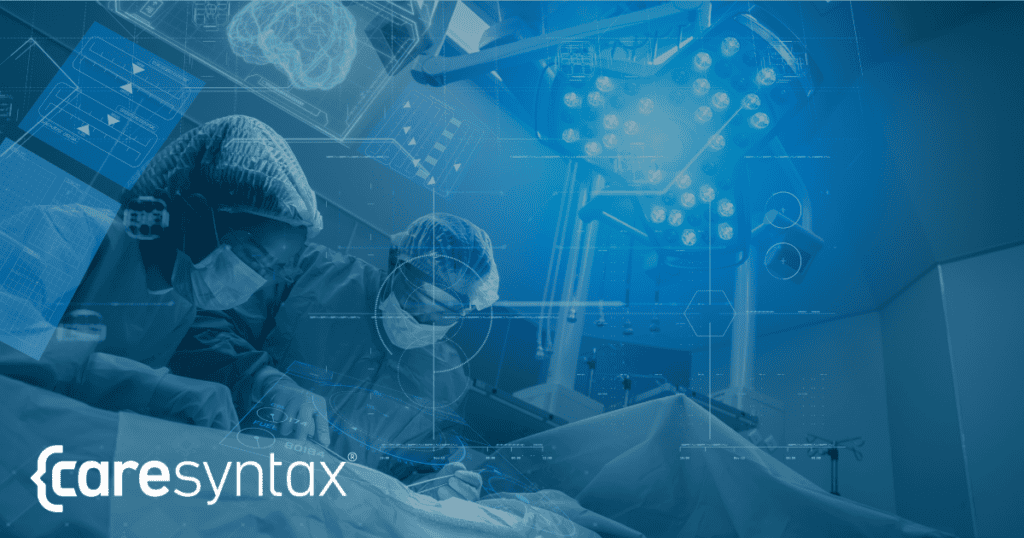Surgery is at the core of any hospital in America, where life-altering decisions are made, and complex procedures are performed under immense pressure. For decades, the patient pathway through surgery has remained relatively unchanged – surgical choices and methods have always defied scrutiny due to years of training, best practice, and experience. But, considering that surgery accounts for 50% of revenue for a hospital, and 10% of preventable patient harm is reported in surgical settings1, transformation of surgery is the next frontier in improving our healthcare system. Luckily, a powerful new force is entering this critical space, poised to revolutionize how surgeries are conducted and ultimately, how patient outcomes are achieved: Artificial Intelligence (AI).
AI is no longer a futuristic concept confined to science fiction or direct to consumer gadgetry. AI has already had an impact across other elements of the hospital revenue cycle model, from patient intake and routing to post-discharge follow-up and care pathways. And now, with increased capability of data models, processing, and algorithmic development, AI’s impact on healthcare, particularly within surgery, is becoming increasingly profound. By seamlessly integrating into the surgical workflow, AI is empowering surgical teams, streamlining processes, and ushering in a new era of precision, efficiency, and patient-centric care.
Beyond Human Limits: AI as a Powerful Surgical Ally
The complexity of modern surgery demands incredible skill, precision, and endurance from surgical teams. Multiple studies have shown the impact of fatigue, stress, and time of day (the daylight savings “spring forward” accounts for 18.7% more patient safety reported incidents2. AI serves as a powerful ally and cognitive aid for these skilled teams, augmenting human capabilities and increasing effectiveness. Here’s how:
- Enhanced Visualization and Precision: AI-powered imaging systems can provide surgeons with real-time, augmented views of the surgical field, highlighting critical structures, identifying potential risks, guiding instruments with unparalleled precision, and even revealing things in real time. Imagine a surgeon being able to “see through” tissues, identifying hidden tumors or delicate nerves with clarity, leading to less invasive procedures and faster recovery times.
- Predictive Analytics for Proactive Care: AI algorithms can analyze vast amounts of patient data, including medical history, pre-operative scans, and even real-time vital signs, to predict potential complications before they arise. This allows care teams to proactively adjust their approach, mitigate risks, and optimize patient outcomes.
- Robotic-Assisted Surgery with Intelligent Automation: AI is taking robotic-assisted surgery to the next level, enabling robots to perform complex tasks with greater precision. Visual overlays of video feeds, clinical decision support tools, and AI-assisted tactile feedback are all examples of AI enhancement to modern robotic systems. AI’s impact can translate to smaller incisions, reduced blood loss, less postoperative pain, and faster recovery for patients.
- Streamlined OR Workflow and Resource Optimization: AI can optimize surgical scheduling, predict procedure duration, and manage equipment and staff resources more efficiently. AI-enhanced systems can also deliver automated notifications to key staff members and clinicians, alerting them to schedule changes, procedure delays, or critical patient updates. This reduces delays, minimizes downtime, and maximizes the utilization of valuable resources, ultimately leading to increased surgical throughput and greater access to care for patients.
- AI-Driven Surgical Setup and Inventory Management: AI can revolutionize preparation by analyzing upcoming surgical schedules to automatically generate customized setup instructions for each procedure. This can include specifying the required instruments, equipment, and supplies for each procedure, ensuring everything is readily available and optimally positioned within each room. Furthermore, AI-powered systems can track instrument usage, identify unused and wasted equipment, and optimize inventory levels to reduce unnecessary costs and improve efficiency.
- Real-Time Monitoring for Enhanced Patient Safety: AI algorithms can act as a vigilant “second set of eyes”across all surgeries, continuously monitoring patient vital signs, anesthesia levels, and other critical parameters. By detecting subtle anomalies or deviations from established norms, AI can alert the surgical team to potential patient safety events in real time, enabling prompt intervention and preventing adverse outcomes. This continuous monitoring can be crucial in the constant high-pressure environment of surgery.
- Automating and Optimizing Workflow: AI can streamline various aspects of the surgical workflow, from preoperative planning to postoperative care. For example, AI-powered systems can automate documentation, generate operative reports, and even suggest optimal postoperative care pathways based on individual patient data. By automating routine tasks, AI frees up valuable time for surgical staff to focus on direct patient care and complex decision making.
- Determining the Optimal Site for Surgery: Before a patient even enters surgery, AI can play a crucial role in determining the safest, easiest, and most appropriate setting for their procedure. By analyzing a patient’s comprehensive medical history, including pre-existing conditions, age, overall health status, and the complexity of the planned surgery, AI algorithms can assess individual patient risk factors and recommend the optimal site of care. This ranges from an ambulatory surgical center (low-risk procedures on healthier patients), to a traditional hospital outpatient setting (medium-risk procedures with some short-term post-op monitoring requirement), to a full inpatient surgical stay (for complex cases and patients with higher risk profiles). This ensures patients are treated in environments best equipped to handle their specific needs, maximizing safety and optimizing resource utilization.
- Dynamic Schedule Optimization — The “Google Maps” of the surgical theater: Inevitably, delays and unanticipated schedule changes occur in the OR. AI can act as a digital navigator for the surgical suite, dynamically adjusting the schedule in real time to keep the OR running at peak performance. When a case runs long, equipment malfunctions, or an emergency surgery arises, AI can rapidly analyze the situation and suggest the best alternative schedule. This intelligent rescheduling can take into account the dynamics of equipment availability, staff expertise and availability, room constraints, and patient acuity, all while striving to minimize overtime costs, maintain patient safety, and minimize delays in patient care. Just like a navigation app reroutes cars around a traffic jam, AI can navigate the complexities and dynamic nature of the OR schedule to find the most efficient path forward.
The Patient at the Center: A Future of Improved Outcomes
The ultimate beneficiary of AI’s integration into the OR is the patient. The advancements driven by AI translate to tangible improvements in patient care, including:
- Reduced stress through the surgery: AI-powered tools streamline the surgical journey, minimizing wait times and enabling personalized treatment plans for faster recovery. This translates to less anxiety, better communication with healthcare providers, and a smoother, less traumatic surgical experience overall.
- Minimally Invasive Procedures: AI-powered tools and robotic systems enable surgeons to perform complex procedures through smaller incisions, reducing trauma to the body and leading to quicker recovery and shorter hospital stays.
- Reduced Complications: AI’s predictive capabilities and enhanced visualization help surgeons avoid complications and make more informed decisions during surgery.
- Improved Surgical Precision and Accuracy: AI assists surgeons in achieving greater precision, leading to better surgical outcomes and reduced risk of errors.
- Increased Access to Care: By optimizing surgical efficiency, throughput, and use of secondary surgery centers, AI can address surgical backlogs and expand access to care for more patients.
Navigating the Path Forward: Collaboration and Ethical Considerations
As we embrace the transformative potential of AI in surgery, it’s crucial to address ethical considerations and ensure responsible implementation. Data privacy, algorithmic bias, demographic bias, and the need for ongoing human oversight are critical areas that require careful attention. Furthermore, collaboration between surgeons, engineers, data scientists, and ethicists is essential to develop and deploy AI solutions that are safe, effective, and aligned with the highest standards of patient care.
The Future is Now: Embracing the AI-Enhanced OR
The integration of AI into the operating room is not just an incremental improvement; it’s a paradigm shift. It’s about creating a future where surgeries are safer, more precise, and less invasive, leading to better outcomes and improved quality of life for patients. By embracing this transformative technology responsibly and collaboratively, we can unlock the full potential of AI-enhanced surgery and usher in a new era of healthcare, with the patient at the center of it all.

